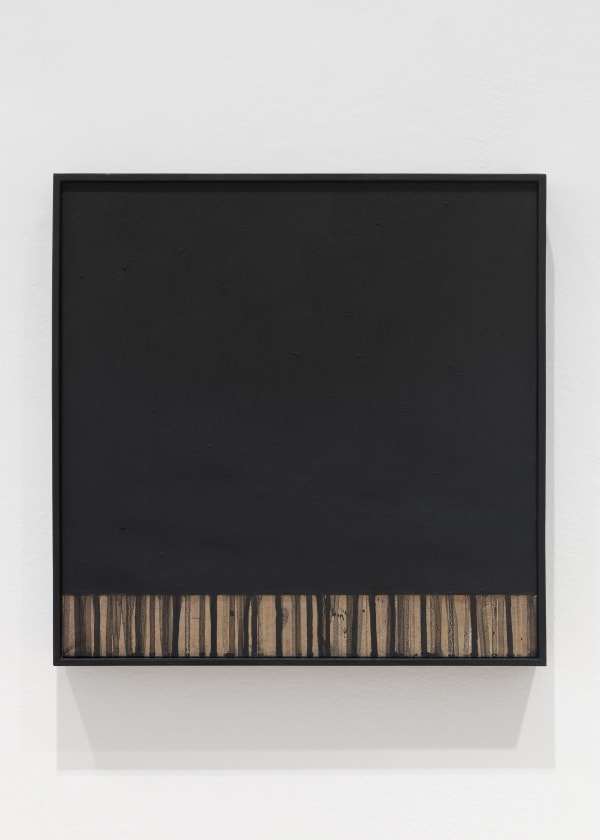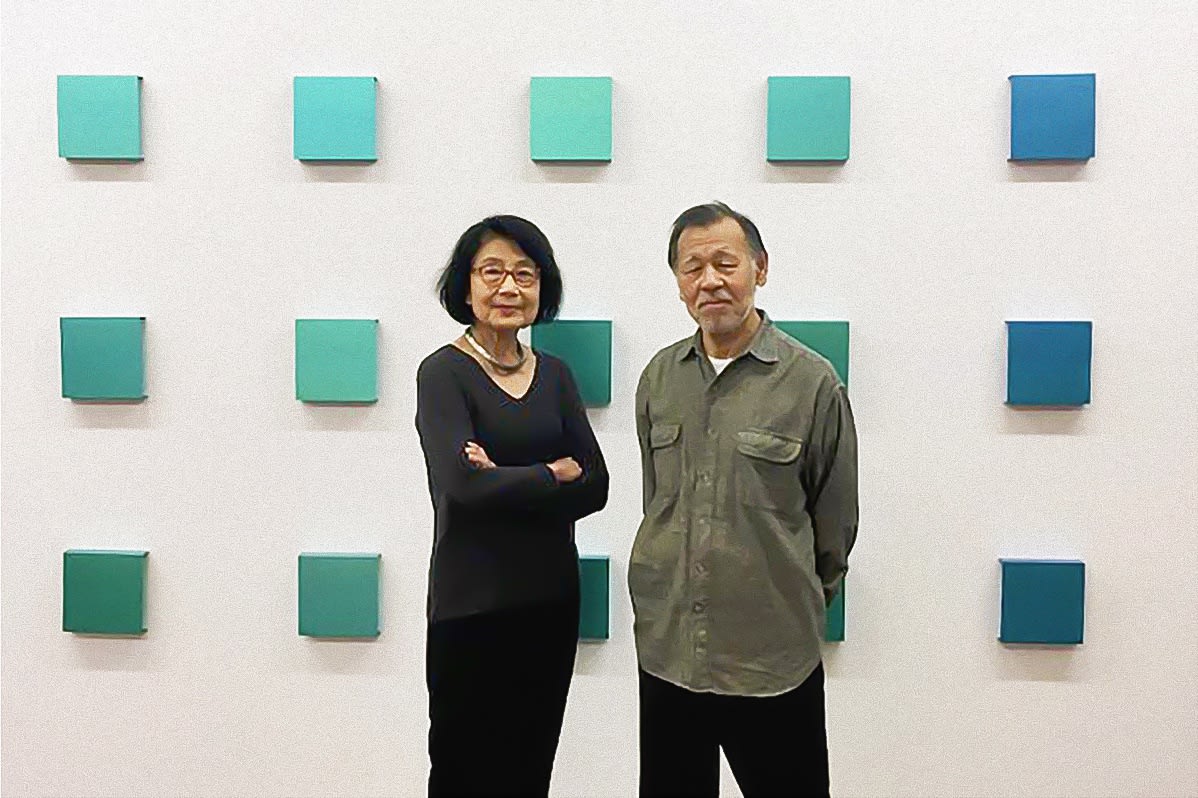Kuwayama / Naito
Past exhibition
Installation Views
Works
-
 Tadaaki KuwayamaTK1017 3/8-60, 1960Black dry pigment and silver leaf on paper and on canvas44 x 44 cm
Tadaaki KuwayamaTK1017 3/8-60, 1960Black dry pigment and silver leaf on paper and on canvas44 x 44 cm
17 3/8 x 17 3/8 inches -
 Rakuko NaitoRN1212-4 1/2-07, 2007Crinkled paper30.5 x 30.5 x 11.4 cm
Rakuko NaitoRN1212-4 1/2-07, 2007Crinkled paper30.5 x 30.5 x 11.4 cm
12 x 12 x 4 1/2 inches -
 Tadaaki KuwayamaTK8147-61, 1961Black dry pigment with silver leaf on paper on canvas119.4 x 60.3 cm
Tadaaki KuwayamaTK8147-61, 1961Black dry pigment with silver leaf on paper on canvas119.4 x 60.3 cm
47 x 23 3/4 inches -
 Rakuko NaitoRN1412-4 1/2-14, 2014V fold w/ burnt edge30.5 x 30.5 x 11.4 cm
Rakuko NaitoRN1412-4 1/2-14, 2014V fold w/ burnt edge30.5 x 30.5 x 11.4 cm
12 x 12 x 4 1/2 inches -
 Tadaaki KuwayamaTK11933-61, 1961Black acrylic on paper on board83.8 x 61 cm
Tadaaki KuwayamaTK11933-61, 1961Black acrylic on paper on board83.8 x 61 cm
33 x 24 inches -
 Rakuko NaitoRN1624-5-07, 2007Indian cotton ball61 x 61 x 12.7 cm
Rakuko NaitoRN1624-5-07, 2007Indian cotton ball61 x 61 x 12.7 cm
24 x 24 x 5 inches -
 Tadaaki KuwayamaTK8742 1/2-61, 1961Red pigment with silver leaf108 x 76.2 cm
Tadaaki KuwayamaTK8742 1/2-61, 1961Red pigment with silver leaf108 x 76.2 cm
42 1/2 x 30 inches -
 Rakuko NaitoRN2336-3 1⁄2-15, 2015Japanese paper on board (small checker board)91.4 x 91.4 x 8.9 cm
Rakuko NaitoRN2336-3 1⁄2-15, 2015Japanese paper on board (small checker board)91.4 x 91.4 x 8.9 cm
36 x 36 x 3 1/2 inches -
 Tadaaki KuwayamaTK11722 3/4-61, 1961White tape on board with acrylic paint35.6 x 57.8 cm
Tadaaki KuwayamaTK11722 3/4-61, 1961White tape on board with acrylic paint35.6 x 57.8 cm
14 x 22 3/4 inches -
 Tadaaki KuwayamaTK9536-61, 1961Black dry pigment on tape on board with bronze leaf91.4 x 62.2 cm
Tadaaki KuwayamaTK9536-61, 1961Black dry pigment on tape on board with bronze leaf91.4 x 62.2 cm
36 x 24 1/2 inches -
 Rakuko NaitoRN2412-3 1/2-16, 2016Small soft cubes30.5 x 30.5 x 8.9 cm
Rakuko NaitoRN2412-3 1/2-16, 2016Small soft cubes30.5 x 30.5 x 8.9 cm
12 x 12 x 3 1/2 inches -
 Tadaaki KuwayamaTK6418-61, 1961Red dry pigment on paper in wooden box45.7 x 30.5 cm
Tadaaki KuwayamaTK6418-61, 1961Red dry pigment on paper in wooden box45.7 x 30.5 cm
18 x 12 inches -
 Rakuko NaitoRN2112-3 1⁄2-16, 2016Japanese paper on board (small cone)30.5 x 30.5 x 8.9 cm
Rakuko NaitoRN2112-3 1⁄2-16, 2016Japanese paper on board (small cone)30.5 x 30.5 x 8.9 cm
12 x 12 x 3 1/2 inches -
 Tadaaki KuwayamaTK7448-61, 1961Black dry pigment on paper on board with aluminium strip121.9 x 92.7 cm
Tadaaki KuwayamaTK7448-61, 1961Black dry pigment on paper on board with aluminium strip121.9 x 92.7 cm
48 x 36 1/2 inches -
 Rakuko NaitoRN2436-3 1/2-18, 2018Japanese paper on board (Soft edge roll)91.4 x 91.4 x 8.9 cm
Rakuko NaitoRN2436-3 1/2-18, 2018Japanese paper on board (Soft edge roll)91.4 x 91.4 x 8.9 cm
36 x 36 x 3 1/2 inches -
 Tadaaki KuwayamaTK7636-61, 1961Deep green pigment on paper on board91.4 x 61 cm
Tadaaki KuwayamaTK7636-61, 1961Deep green pigment on paper on board91.4 x 61 cm
36 x 24 inches -
 Rakuko NaitoRN618 1/2-3 1/2-18, 2018Japanese paper on board (Irregular strips)47 x 47 x 8.9 cm
Rakuko NaitoRN618 1/2-3 1/2-18, 2018Japanese paper on board (Irregular strips)47 x 47 x 8.9 cm
18 1/2 x 18 1/2 x 3 1/2 inches -
 Tadaaki KuwayamaTK948-62, 1962White tape on board with acrylic paint121.9 x 77.5 cm
Tadaaki KuwayamaTK948-62, 1962White tape on board with acrylic paint121.9 x 77.5 cm
48 x 30 1/2 inches -
 Rakuko NaitoRN1212-3 1/2-19, 2019Japanese paper on board (soft edge free form)30.5 x 30.5 x 8.9 cm
Rakuko NaitoRN1212-3 1/2-19, 2019Japanese paper on board (soft edge free form)30.5 x 30.5 x 8.9 cm
12 x 12 x 3 1/2 inches -
 TADAAKI KUWAYAMA, TK1826-63, 1963
TADAAKI KUWAYAMA, TK1826-63, 1963 -
 RAKUKO NAITO, RN1417 1/2-2 1/2-21, 2021
RAKUKO NAITO, RN1417 1/2-2 1/2-21, 2021 -
 Tadaaki KuwayamaTK4612 3/4-64, 1964Gold leaf on board32.4 x 32.4 cm
Tadaaki KuwayamaTK4612 3/4-64, 1964Gold leaf on board32.4 x 32.4 cm
12 3/4 x 12 3/4 inches -
 RAKUKO NAITO, RN1317 1/2-2 1/2-21, 2021
RAKUKO NAITO, RN1317 1/2-2 1/2-21, 2021 -
 Tadaaki KuwayamaTK4212 3/4-64, 1964Silver on paper on board32.4 x 32.4 cm
Tadaaki KuwayamaTK4212 3/4-64, 1964Silver on paper on board32.4 x 32.4 cm
12 3/4 x 12 3/4 inches -
 RAKUKO NAITO, RN518-5-22, 2022
RAKUKO NAITO, RN518-5-22, 2022 -
 Tadaaki KuwayamaTK4716-64, 1964Silver leaf on paper tape on board28.3 x 41 cm
Tadaaki KuwayamaTK4716-64, 1964Silver leaf on paper tape on board28.3 x 41 cm
11 1/8 x 16 1/8 inches -
 Tadaaki KuwayamaTK8932-1/2-’66, 1966Acrylic on canvas82.5 x 82.5 cm
Tadaaki KuwayamaTK8932-1/2-’66, 1966Acrylic on canvas82.5 x 82.5 cm
32 1/2 x 32 1/2 inches
Overview
Tadaaki Kuwayama (b. 1932 Nagoya, Japan) and wife Rakuko Naito (b. 1935 Tokyo, Japan) both studied at the Nihonga (modern Japanese-style painting) program of Tokyo National University of Fine Arts and Music. In 1958 they left the conservative Tokyo for New York City where they have lived and worked together ever since throughout their impressive six-decade career. Belonging to the generation of diasporic Japanese artists born before World War II who have lived in New York, including Arakawa, Yoko Ono, Yayoi Kusama, and Minoru Niizuma who all escaped the censorship of the totalitarian regime of which Art would be subject to. In New York the couple flourished and played integral roles in the Minimalism movement, where artists favoured industrial materials, avoided overt symbolism and emotional content, and instead called attention to the materiality of the works, working alongside artists such as Donald Judd and Frank Stella.
The work of Tadaaki Kuwayama is characterised by “radical neutrality,” as art historian Michio Hayashi describes it. Since the early 1960s, Kuwayama has adamantly broken from existing modes of artistic expression in order to create neutral art where the artist removes all the characteristics from a painting to the degree where you can no longer judge the painting with aesthetic conventions. His most representative work from the mid-1960s comprised of four equivalent squares, each framed by aluminium strips and bordered by thin black lines. This structure has no top or bottom; hence, the work is free of composition. His remarkably neutral panels challenge people, as they can no longer judge his painting as “good or bad.”
In order to fully appreciate Kuwayama’s artworks, the viewers need to leave one’s own conventional ideas behind.
In 1961 Kuwayama had his first solo exhibition at Green Gallery, a prominent vanguard venue in New York that featured many up-and-coming artists, including Dan Flavin, Donald Judd, Yayoi Kusama, Robert Morris, and Andy Warhol. In that year, Kuwayama already was part of the Carnegie International, and Art in America featured him as “New Talent USA,” in 1964. The future Minimalist, Donald Judd, then a young critic with Arts magazine, had reviewed every solo exhibition of Kuwayama’s until 1964. However, unlike Minimalists, who were not reluctant to employ the commercially available fluorescent lights or industrial paints, Kuwayama acquires industrial effects in his work by using spray guns and mixing his own pigments and carefully building his work. In this respect, Kuwayama’s work aligns with his generation of European artists, such as the German Zero artist, Otto Piene and his collaborator Yves Klein. Emerging from the totalitarian societies, these artists sought for new materials and methods that can offer “an experience that is completely different from viewing conventional paintings,” so that their art could liberate the ideas and senses of their onlookers.
In the 1960s Naito began as a minimal Op artist experimenting with the Moire effect after being introduced to acrylic paint (an American material) by her friend, the painter Sam Francis. before moving on to working with the paper assemblages that she has dedicated her artistic practice to for the past three decades. Working with kozo and mino washi; traditional Japanese papers which can be traced back to the Nara period in 8th century Japan, Naito contrasts this strong-fibred, man-made material with the organic forms produced by tearing, rolling, folding, and burning the paper. A modern combination of drawing and sculpture, Naito plays with order and structure, strength and vulnerability.
Like Kuwayama, Naito was keen to avoid the artists hand, and any trace of human narrative, with both artists choosing not to use titles (only an alphanumeric identification code) discarding any suggestion of excess with extreme restraint. Naito, however, allows the organic and imperfect forms of the neutral-coloured natural material to take precedence allowing a measure of poetry and philosophical reflection. Naito has said, “I feel natural forms and textures have a reality that can not be competed by trying to paint or drawn by hand. I try to experiment and manipulate materials to create my own world.”
In this exhibition, the intimacies of living and working together is explored where their work is sometimes overtly and sometimes inadvertently linked.
Naito’s work is in the permanent collections of San Francisco Museum of Modern Art, San Francisco, CA; Voorlinden Museum, Wassenaar, Netherlands; Zimmerli Art Museum at Rutgers University, New Brunswick, NJ; Museo de Arte Contemporaneo, Buenos Aires, Argentina; and The Larry Aldrich Museum, Ridgefield, CT. Naito was an artist in Residence at the Josef and Anni Albers Foundation in 2003.
Kuwayama’s work is in the permanent collections of Guggenheim Museum, New York City, New York, USA; 21st Century Museum of Contemporary Art, Kanazawa, Japan; Museum of Contemporary Art, San Diego, California; San Francisco Museum of Modern Art, San Francisco, California; The National Museum of Art, Osaka, Japan; and Indianapolis Museum of Art, Indianapolis, Indiana.
Publications
News

































